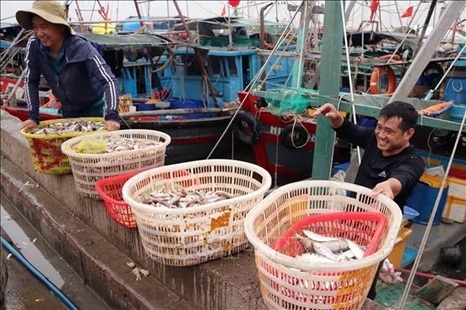Alongside its action plan issued in late October for the peak month against IUU fishing, the northern port city is rolling out comprehensive and drastic measures to help Vietnam secure the removal of the European Commission’s “yellow card” warning in 2025.
A new picture for fishing industry
As of September, Hai Phong had 820 registered fishing vessels, with all registered, licensed, and certified. As many as 283 vehicles 15m and longer have installed vessel monitoring systems (VMS), ensuring continuous 24-hour connectivity. Non-compliant vessels are barred from leaving ports, according to the municipal People’s Committee.
Between April 2024 and September 2025, authorities logged 21,700 port arrivals and departures, overseeing more than 4,400 tonnes of unloaded seafood. Every shipment was cross-checked against voyage data, logbooks and catch reports, achieving 100% traceability and zero foreign waters violations.
    |
 |
|
Hai Phong leads Vietnam’s fight against IUU fishing. |
During 2024–2025, fines have topped 4 billion VND (153,000 USD) for more than 300 cases of violation, mostly for VMS outages, failure to keep logbooks, or unqualified vessels.
The city has established Bach Long Vi and Cat Ba - Long Chau marine protected areas spanning over 35,000ha, plus five marine conservation zones and three inland conservation areas along the Da Do, Van Uc, and Gia rivers. Three restocking drives released 2.1 million juvenile fish, shrimp, crabs, and mollusks to restore the natural ecosystem.
Beyond capture fisheries, Hai Phong is encouraging hi-tech aquaculture integrated with tourism and environmental protection. Ten facilities have swapped wooden cages for HDPE plastics, and over 80 Cat Ba Bay farms are operating in designated areas. Several VietGAP-certified intensive farming models using digital and automated pond management systems have increased productivity and ensured food safety.
Advancing a sustainable blue economy
Under the action plan, Hai Phong will complete the registration, inspection, and relicensing of all eligible vessels by October 30, while sealing and monitoring all non-compliant boats. Authorities are also required to update the National Fisheries Database (VNFishbase) linked with the VNeID national citizen system, to ensure accurate tracking of vessel owners, anchorage locations, and fishing routes.
The city mandates 100% vessel identification marking, full control of all port entries and exits, and enhanced maritime patrols and inspections. Fishing cooperatives and fleet operators must submit weekly progress reports to the Department of Agriculture and Environment, which will compile updates for the Ministry of Agriculture and Environment and the municipal People’s Committee.
A key focus of the plan is digital transformation in fisheries management. Hai Phong has begun deploying electronic fishing logbooks and the eCDT traceability system across all local ports. By mid-November, all vessels 15m or longer must register port arrivals and departures through eCDT, while seafood processors and buyers are required to record catch data on the same platform.
The city also proposed that the ministry upgrade vessel monitoring software, refine the electronic reporting system, and prioritize investment in a new key fishing port at Hai Phong’s major fisheries center and a storm shelter area on Bach Long Vi Island. Additional support policies are being recommended to help fishermen switch to sustainable livelihoods and upgrade VMS equipment for stable connectivity.
Awareness campaigns are being intensified, reaching each fisherman and vessel owner directly, to ensure that every stakeholder understands and complies with anti-IUU fishing regulations.
Source: VNA